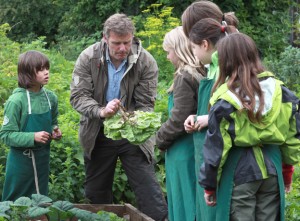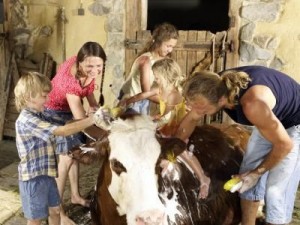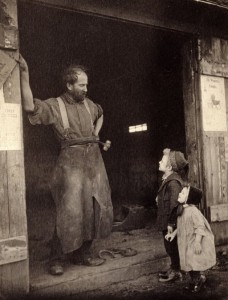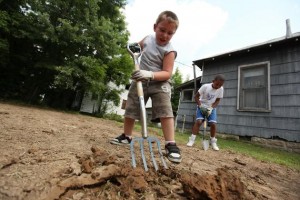Waldorf News
Saving Childhood: Basic Schools and the Future of Waldorf Education

By DR. PETER GUTTENHOEFER
On our beautiful earth, nature is at risk. Flowers and animals disappear from the planet, everybody talks about the climate.
But something else is at risk: childhood.
In every country of the world the pressure on children is increasing: school enrollment is gradually being moved to an earlier age, governmental curriculum is enforced for the first ten years of life, reading is taught at the age of three, competition is being intensified among the children, lots of tests, classes become more intellectual, less movement, no arts, no playing.
At home: family structures are breaking down, stressed parents, unemployment, poverty, children sitting alone in front of the screen, computer games. Even the rich people’s children are poor!
Let us take some necessary steps to preserve childhood! Let us give our children at least ten years of childhood! Only this way will they be able to have enough fantasy to reshape life on earth in a new and better way when they become adults. We’re dealing with the earth and the youth forces of the earth.
The whole idea of “School” must be re-thought anew! Schools, where children can live, play and work in such a way that their natural gift of imagination can turn into creative fantasy. We need schools where they can live without pressure or fear, thus being happy while they learn and grow healthy.
1.) School Endangers Childhood
The civilization that has spread from Western Europe across the world is hostile to childhood. Life in the cities clearly shows this fact: every unsupervised movement of a child is a danger to her life. Playing is forbidden. All that matters is the unlimited self-fulfillment of the adult in every material aspect of his being on earth. Childhood and old age are nothing more than annoying, inevitable side effects.
 Childhood has to be useful. As soon as a child shows the first signs of having her own imagination, governmental regulations intervene: compulsory school attendance for all children. The tendency worldwide is now to anticipate compulsory school enrollment to the fifth year of life. Economic cost-profit thinking drives educational processes, both regarding the organization as well as the contents. It is a known fact that all over the world most teachers are underpaid; to the children’s unhappiness is added that of their teachers. This leads to the default antipathy between teachers and students.
Childhood has to be useful. As soon as a child shows the first signs of having her own imagination, governmental regulations intervene: compulsory school attendance for all children. The tendency worldwide is now to anticipate compulsory school enrollment to the fifth year of life. Economic cost-profit thinking drives educational processes, both regarding the organization as well as the contents. It is a known fact that all over the world most teachers are underpaid; to the children’s unhappiness is added that of their teachers. This leads to the default antipathy between teachers and students.
The child is still seen as an object of socialization, not as the subject of its own upbringing. It is still not regarded as a person who has the right of free development and education, but as a person who must attend school. The truth is that the duty lies in the hands of the adults; when she is born, the child steps into her own rights.
This new consciousness is expressed in the 1989 UN-Convention on the Rights of Children that has been signed by almost every nation in the world.
We can only fully realize the ideals therein formulated when we fully acknowledge what Janusz Korczak has said:
“The child doesn’t only become a human being, it is a human being!”
The current debate about child abuse has brought to light the fact that in those hideous individual cases, a deeper layer of life is brought to the surface, in which unpurified instincts and egoism create a dangerous mixture with the basic instinct of our modern civilization which is the need to take possession of everything. The effects of this deep layer are expressed, among others, in the worldwide despotic pedagogy, in the style of the school buildings, in the lack of flexibility in school timetables; in a word: a regular day of school.
To acknowledge the child as a subject of his self-education is hard enough, but the idea has finally reached mankind. A next step towards change, the direction of which is shown in the following quote from Rudolf Steiner, is necessary:
“Every education is self-education and we as teachers and educators
are only the surroundings of the child educating itself.”
To adapt these surroundings to what the child needs in order to develop fruitfully, would mean, for every adult, a deeply-rooted transformation of living and thinking habits. Civilization would have to be remodeled from the foundations up.
The starting point is the following principle: teachers and children work and learn together. Children of our age don’t accept the “master” anymore, and are even less willing to accept to be isolated from real life all day long through timetables and school rooms. In the best, or worst, case they submit to it. From the age of twelve on they start to defend themselves. Problems that come along are defined as problems of discipline. But the truth is that it is in the child’s very nature to desire to be active, but the school of our modern time prevents the child from being productively active.
 The child’s will is projected towards activity; teachers and educators should derive the program for their self-education. Rudolf Steiner’s pedagogy was originally based upon the fact that the teacher is a learner and does not necessarily have to be an academically educated pedagogue. Today we can add: Teachers must be workers. To put it the other way round: why are farmers and craftsmen not involved in the process of education and upbringing? The typical teacher today is a person who is released from productive work at the costs of society in order to concentrate on educating children. Even the children themselves are freed from any kind of work to have time for learning. In rich countries this situation is ideally supposed to last up to the age of 25 or 30 and it is slowly becoming evident that our economies cannot pay for it. That it is an important contributor to the ruin of the earth has become clear only to a few.
The child’s will is projected towards activity; teachers and educators should derive the program for their self-education. Rudolf Steiner’s pedagogy was originally based upon the fact that the teacher is a learner and does not necessarily have to be an academically educated pedagogue. Today we can add: Teachers must be workers. To put it the other way round: why are farmers and craftsmen not involved in the process of education and upbringing? The typical teacher today is a person who is released from productive work at the costs of society in order to concentrate on educating children. Even the children themselves are freed from any kind of work to have time for learning. In rich countries this situation is ideally supposed to last up to the age of 25 or 30 and it is slowly becoming evident that our economies cannot pay for it. That it is an important contributor to the ruin of the earth has become clear only to a few.
School today is the result of the cultural processes in Middle Europe over the last 250 years, which have brought about the fragmentation of life processes. This fragmentation is painfully visible in the fact that learning and working, playing and working, craftsmanship and education, childhood and industrial societies, rural and urban life have been fully separated from each other. Today school is a place where children become alienated from life. Dispositions are artificial and the so-called “motivation” of students is nothing more than the coercion deriving from the need to pass exams and to earn the related qualifications. This is hostile to children because the child is a being of the present which experiences its sense of existence directly in a spiritual-sensitive way, and not through an envisaged future or by any representation of gaining some competences.
2.) Transformation of School
What would a school look like that reflected the needs of today’s children? Novalis showed the way in his fragment “Paedagogik”:
“Education of children, is like the training of an apprentice,
by them gradually taking part in the activities of adults, and not through direct education.”
The educating adults must be busy! But not busy in the direct education of children, but busy with work that originates from life’s needs. This also includes writing, reading, calculating, and singing. And how does the apprentice learn? In the first seven years by imitation, in the second seven years by following the adult’s model. This creates images of adults working meaningfully, whose work is worth being imitated and the model followed, because the adults express themselves in visible activities, in movements of arms and legs reasonably conducted. And the genius of the child who lives in the environment of such occupations is seen in the process of practicing her self-education by imitating and following the model of adults. This we call play.
Occupations worth imitating are farming and gardening, craftsmanship and domestic economy, where “food” is produced through the transformation of substances and which, unfortunately are not part of the educational field called “school”. Rudolf Steiner has introduced them in the field of teaching; this is one of the distinctive features of Waldorf education. Especially in these fields mankind is becoming increasingly aware that a reductionistic view of the world and the egoistic striving for profits lead to the destruction of the fundamentals of life. This can already be seen in the catastrophic impact of industrialized farming on soil and landscape, on bees, on the quality of our food etc., it is shown in the torture of our animals, in the dying of our woods.
 The destruction of ecological systems and the dangers of climate change wake us up and demand new strategies. Here ideas come together: adults turn back to the earth und abandon the idea of endlessly growing profits and massive livestock breeding; the respect for our fellow creatures who are willing to serve us becomes the guideline for our decisions. And they take the children with them! They don’t confine them in kindergartens, nurseries, schoolrooms, but they work together with the adults, the younger ones playing, the older ones gradually participating in the activities that the grown-ups do, as Novalis wrote. We feel the need for a new curriculum. We see a new ranking of subjects as main and side subjects, and the worldwide Holy Cows of the mastery of the mother tongue, of national literature and mathematics are ranked at the same level as the new main subjects of farming and craftsmanship.
The destruction of ecological systems and the dangers of climate change wake us up and demand new strategies. Here ideas come together: adults turn back to the earth und abandon the idea of endlessly growing profits and massive livestock breeding; the respect for our fellow creatures who are willing to serve us becomes the guideline for our decisions. And they take the children with them! They don’t confine them in kindergartens, nurseries, schoolrooms, but they work together with the adults, the younger ones playing, the older ones gradually participating in the activities that the grown-ups do, as Novalis wrote. We feel the need for a new curriculum. We see a new ranking of subjects as main and side subjects, and the worldwide Holy Cows of the mastery of the mother tongue, of national literature and mathematics are ranked at the same level as the new main subjects of farming and craftsmanship.
An ideal surrounding for this kind of education would be a farm. But the farm itself needs a deeprooted modification and renewal, if it is supposed to be a
“complete surrounding” (Goethe, Pädagogische Provinz)
for the self-educating child and, at the same time, support the farmers that live and work in it. So, we don’t mean a “school farm” but a community of working people who, by devoting themselves to bio-dynamic farming, want to recover the youth forces of the earth itself. Again, no direct education, which is disadvised by Novalis, but the integration of the child into this working environment, where she can live in the adult’s stream of will. The schoolroom also belongs to this environment, but changed in its form. Outer and inner rooms become together a complete surrounding. The way this can be created in detail depends on many conditions and cannot be discussed here.
It is obvious that the ideas mentioned here point to one specific direction where the ideal is to be guessed and should be searched for. However, we would be blind to reality to expect that bio-dynamic farming could also save pedagogy.
Two ideas lead us further:
1.“A farm” would be the ideal surrounding but is not a condition. “School” has developed mainly in urban areas and so it has to be substantially transformed inside the urban civilization. Urban civilization itself, as previously said, needs to be redesigned, and this can only be achieved through a completely new way of educating children and is a process that will take decades or even centuries.
2.Under the current political, social and cultural conditions of most countries of the world, this change in pedagogic paradigms can only be thought if we are willing to transform the “school” into a learning place where children, at first in small scale, grow up to become fully capable of forming the future.
3.) Small Is Beautiful
What a human learns in her first years of life – and how she learns it – is extremely important to shape the course of life. We will not consider here the first three years of life, as we wish every child on earth to grow up at least in this first period of life within a loving family. That this wish is not a reality for hundreds of thousands of children leads into a new area of difficulties.
 This is about drawing a draft picture of a learning place where the child can live, learn and blossom from the 4th to the 10th year of life; a sketch of “school”, in which three years of kindergarten and four years of school establish a continuum of seven years. At the end of this development phase the child has reached a stage where, according to modern “salutogenesis” research, she is equipped with the “basic tools” of the faculties of coherence (inner connection with the world) and resilience (the power to acknowledge and overcome obstacles).
This is about drawing a draft picture of a learning place where the child can live, learn and blossom from the 4th to the 10th year of life; a sketch of “school”, in which three years of kindergarten and four years of school establish a continuum of seven years. At the end of this development phase the child has reached a stage where, according to modern “salutogenesis” research, she is equipped with the “basic tools” of the faculties of coherence (inner connection with the world) and resilience (the power to acknowledge and overcome obstacles).
At this stage in childhood development, which is pictorially called “the Rubicon” in anthroposophic anthropology, the child has established to some extent her individual biological, emotional and spiritual health which are the source of power that enables it to manage the crisis of the following years and of life in general.
If a child is allowed to grow up, at least to the above mentioned age, in an atmosphere in which the “free unfolding of her personality”, as is required by the fundamental law, has had the possibility and the time to take place, she will be fit for the challenges to come. Within this period, that comprises three years of kindergarten and four years of “school,” learning need not be ruled by governmental performance standards. It is thinkable that the children’s performance structure in the 4th year of school is adapted to governmental guidelines to allow them to move to any other school without problems. (In many countries there is also the possibility of “home-schooling” for the primary school period). At least the first three years of school could be freely devised, and certainly the three years before school starts.
This 7-year period that we are presently considering, should be strictly structured according to the psychological development of the child and the pedagogic points of view. Especially during the transition from kindergarten to school can we follow distinctive developments of individual children; this would lead to a structure which could ease the problems caused by the early school enrollment that is being promoted all over the world. We comply with the required school attendance but the details of the pedagogic methods are freely definable.
In many places on earth, where social, economic or cultural conditions are adverse to the establishment of a governmental system, or even a multi-articulated school system, such small “schools” should be established with little means: not every teacher and educator needs an academic background; on the contrary, completely different competences are also required other than only those that can be acquired by attending Universities or teacher seminars. We don’t have to think about expensive school buildings; no large teacher council, which quarrels to exhaustion in the conflicts of group dynamics, financial aspects, organization and school administration remain manageable. In a word: Small is beautiful, according to the world famous book by E.F. Schumacher, 1973.
 In some countries – mainly in the southern hemisphere – school politics carry on what colonialism did, even if it is considered to be over: to implant the European and American way of living and thinking into the young souls of peoples who are politically free but often badly shaken in their identity. The leading elite of those peoples send their children to “International schools” or to the boarding schools of their former colonial masters; primary schools are conceivably badly equipped and structure their curricula according to European requirements which, as is well known, also carry with them a “hidden curriculum” whose world conception is equally as far away from modern scientific cognition as it is from the still surviving wisdom of peoples living in a traditional way.
In some countries – mainly in the southern hemisphere – school politics carry on what colonialism did, even if it is considered to be over: to implant the European and American way of living and thinking into the young souls of peoples who are politically free but often badly shaken in their identity. The leading elite of those peoples send their children to “International schools” or to the boarding schools of their former colonial masters; primary schools are conceivably badly equipped and structure their curricula according to European requirements which, as is well known, also carry with them a “hidden curriculum” whose world conception is equally as far away from modern scientific cognition as it is from the still surviving wisdom of peoples living in a traditional way.
A significant contribution to the acquisition of a new identity is only possible through careful consideration of their own cultural and spiritual roots, of their own language, of the surrounding landscape, etc. Today this is only possible in the first few years of school, trying to avoid excessive conflicts with the school authorities in charge in each country. In higher grades it is about adapting the students to the present social system of society into which they are to integrate. This is what governments have to do.
4.) Basic School
In those seven years it’s about allowing childhood to blossom, individual health to develop, create the foundations of general education and to practice work. Waldorf pedagogy, which has been spreading all over the world for the last 90 years, works, starting from the anthroposophical knowledge of man given by Rudolf Steiner, on the anthropological and methodological principles of this assignment. Besides the development of intelligence and the unfolding of the child’s soul, special focus is given to the development of her willpower. According to the basic ideas of elementary pedagogy that are discussed herein, Waldorf-pedagogy shows its need to be further developed. Looking at the children’s needs and led by the question “What do the children of today need to know in 30 years?” this shows us our tasks which are presented in paragraph 2.). To change curricular contents and methods in secondary and high school confronts us with the obstacles that were mentioned before. The first four years of school and the kindergarten are, as previously said, the most modifiable.
 The full beauty and depth of Waldorf pedagogy already unfold themselves in the first four years; work and play flow one into the other, the world contents reveal themselves through images; children and teachers co-operate to the formation of a destiny community, in which there is no competition but where mutual help is practiced. In every sixth grade new problems arise, because the children’s relationship with the world and with other people constitutionally changes at the age of twelve. Basic School could also be prolonged into the 5th grade, depending on the possibilities and circumstances of the location and the people. But work in the 6th grade would be determined by completely new didactical and methodological guidelines. For this reason Basic School should only last for the first four, maximum five years of school. To this new school form also belong, as previously said, three years of Kindergarten for a total of seven or eight years altogether.
The full beauty and depth of Waldorf pedagogy already unfold themselves in the first four years; work and play flow one into the other, the world contents reveal themselves through images; children and teachers co-operate to the formation of a destiny community, in which there is no competition but where mutual help is practiced. In every sixth grade new problems arise, because the children’s relationship with the world and with other people constitutionally changes at the age of twelve. Basic School could also be prolonged into the 5th grade, depending on the possibilities and circumstances of the location and the people. But work in the 6th grade would be determined by completely new didactical and methodological guidelines. For this reason Basic School should only last for the first four, maximum five years of school. To this new school form also belong, as previously said, three years of Kindergarten for a total of seven or eight years altogether.
Thus we have the picture of a minimal form of “school” that offers a complete pedagogic proposal for children between four and ten years of age. It is not a fragment of a regular school, not “just” a primary school, but a new complete institution, which means the creation of a new learning place for children. It can be established with relatively low financial means and manpower; the responsibility for a possible further path of education of children can only lie in the hands of those who offer the means for it. In order to imagine such a Basic School we must abandon the idea of a Waldorf school that takes twelve years of education, and focus on the powers and competences which are at hand in times of childhood crisis. The small “schools” will become seeds for completely new learning places, whose detailed image we still lack the fantasy to conceive. We want to build rescue islands for childhood and therefore also for mankind’s ability to use its fantasy.
Peter Guttenhöfer, who has a PhD in history, including the history of literature and the history of art, has been a teacher at the Waldorf School in Kassel, Germany, since 1972. For the past 26 years he has also been engaged in teacher training at the Seminar for Waldorf Teacher Training in Kassel. He is also a member of the Educational Research Institute of the Association of Waldorf Schools in. Since 1980, Dr. Guttenhöfer has educated teachers and advised schools in many countries around the world. “Saving Childhood” originally appeared here.
 Middle School Science With Roberto Trostli
Middle School Science With Roberto Trostli The Journey is Everything
The Journey is Everything Caring for All Stages of Life
Caring for All Stages of Life Quality Education in the Heartland
Quality Education in the Heartland Space speaks. Its language is movement.
Space speaks. Its language is movement. Flexible preparation for your new grade
Flexible preparation for your new grade
 Train to Teach in Seattle
Train to Teach in Seattle Roadmap to Literacy Books & Courses
Roadmap to Literacy Books & Courses Immersive Academics and Arts
Immersive Academics and Arts Association for a Healing Education
Association for a Healing Education Transforming Voices Worldwide
Transforming Voices Worldwide Waldorf-inspired Homeschool Curriculum
Waldorf-inspired Homeschool Curriculum ~ Ensoul Your World With Color ~
~ Ensoul Your World With Color ~ Bay Area Teacher Training
Bay Area Teacher Training Everything a Teacher Needs
Everything a Teacher Needs Apply Today: New Cohort Starts Nov. 2025
Apply Today: New Cohort Starts Nov. 2025 Great books for Waldorf Teachers & Families
Great books for Waldorf Teachers & Families Summer Programs - Culminating Class Trips
Summer Programs - Culminating Class Trips Waldorf Training in Australia
Waldorf Training in Australia Jamie York Books, Resources, Workshops
Jamie York Books, Resources, Workshops Bringing Love to Learning for a Lifetime
Bringing Love to Learning for a Lifetime Full-Time Teacher Education
Full-Time Teacher Education FEB Conference in Fair Oaks Register Now
FEB Conference in Fair Oaks Register Now RSS Feeds
RSS Feeds